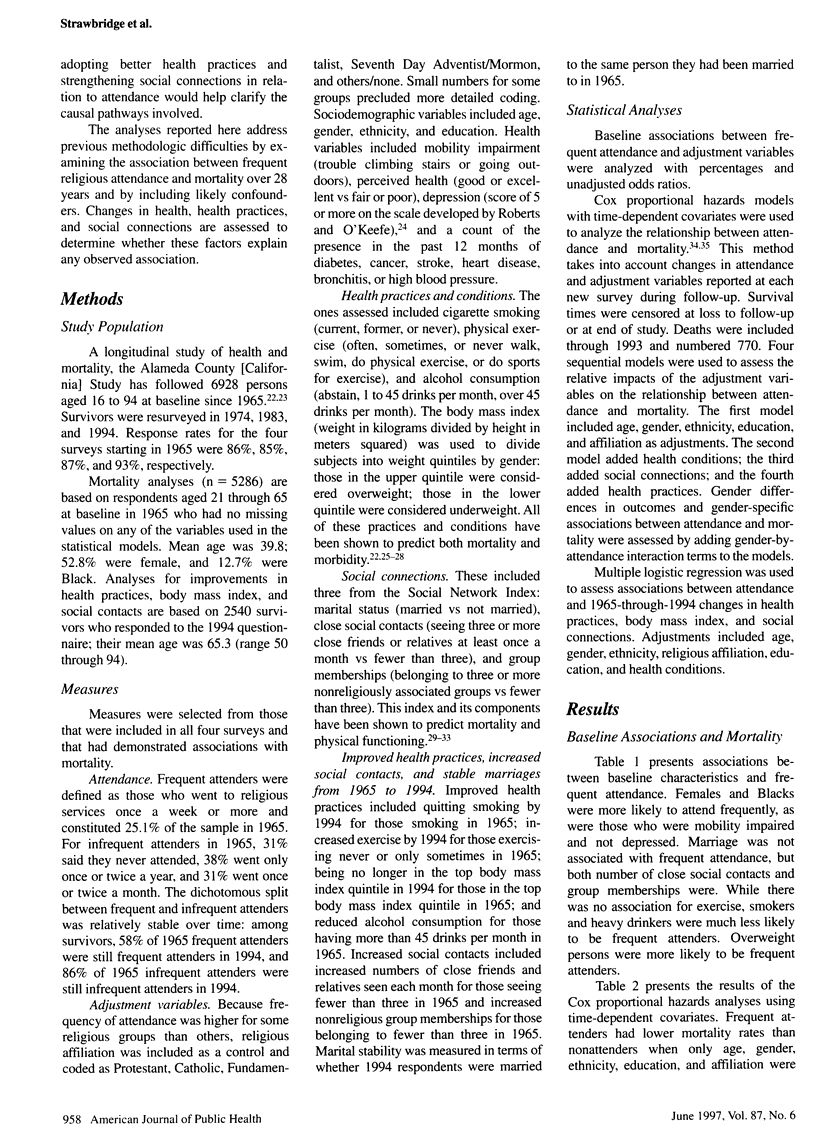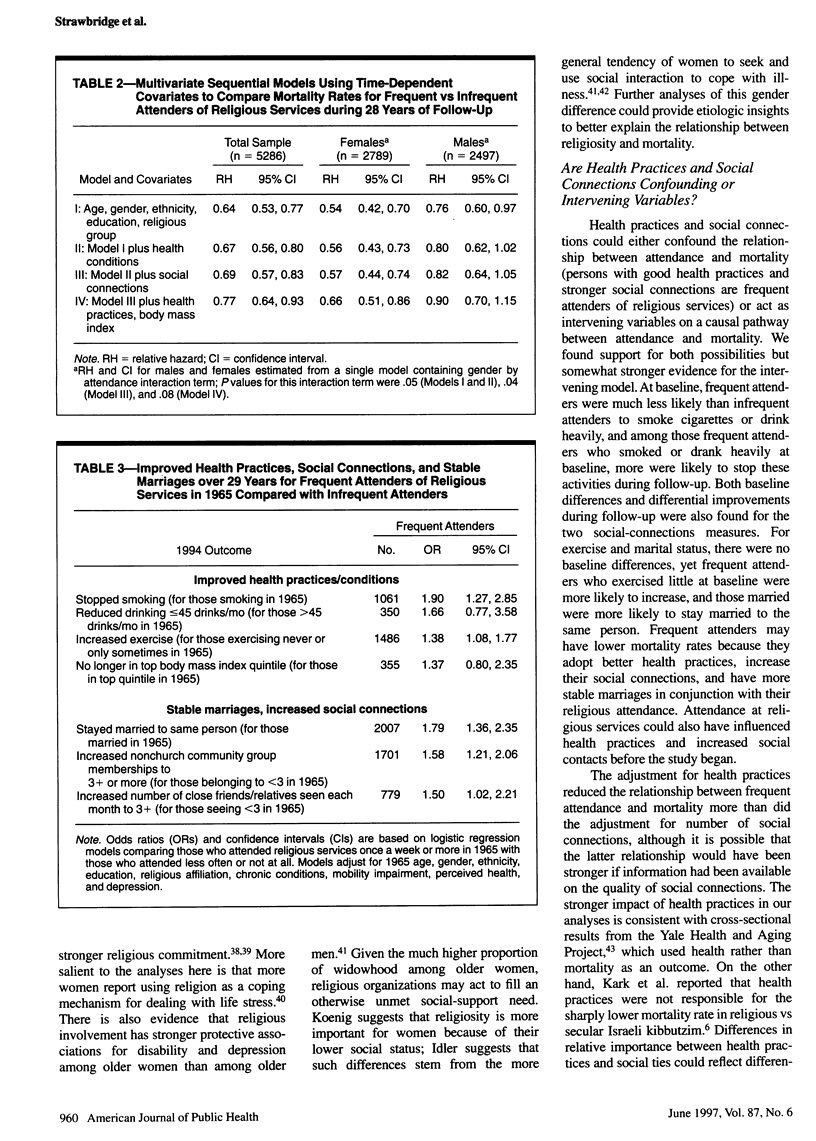Abstract
OBJECTIVES: This study analyzed the long-term association between religious attendance and mortality to determine whether the association is explained by improvements in health practices and social connections for frequent attenders. METHODS: The association between frequent attendance and mortality over 28 years for 5286 Alameda Country Study respondents was examined. Logistic regression models analyzed associations between attendance and subsequent improvements in health practices and social connections. RESULTS: Frequent attenders had lower mortality rates than infrequent attenders (relative hazard [RH] = 0.64;95% confidence interval [CI] = 0.53,0.77). Results were stronger for females. Health adjustments had little impact, but adjustments for social connections and health practices reduced the relationship (RH = 0.77; 95% CI = 0.64, 0.93). During follow-up, frequent attenders were more likely to stop smoking, increase exercising, increase social contacts, and stay married. CONCLUSIONS: Lower mortality rates for frequent religious attenders are partly explained by improved health practices, increased social contacts, and more stable marriages occurring in conjunction with attendance. The mechanisms by which these changes occur have broad intervention implications.
Full text
PDF




Selected References
These references are in PubMed. This may not be the complete list of references from this article.
- Berkman L. F., Syme S. L. Social networks, host resistance, and mortality: a nine-year follow-up study of Alameda County residents. Am J Epidemiol. 1979 Feb;109(2):186–204. doi: 10.1093/oxfordjournals.aje.a112674. [DOI] [PubMed] [Google Scholar]
- Broadhead W. E., Kaplan B. H., James S. A., Wagner E. H., Schoenbach V. J., Grimson R., Heyden S., Tibblin G., Gehlbach S. H. The epidemiologic evidence for a relationship between social support and health. Am J Epidemiol. 1983 May;117(5):521–537. doi: 10.1093/oxfordjournals.aje.a113575. [DOI] [PubMed] [Google Scholar]
- Comstock G. W., Partridge K. B. Church attendance and health. J Chronic Dis. 1972 Dec;25(12):665–672. doi: 10.1016/0021-9681(72)90002-1. [DOI] [PubMed] [Google Scholar]
- Comstock G. W., Tonascia J. A. Education and mortality in Washington County, Maryland. J Health Soc Behav. 1978 Mar;18(1):54–61. [PubMed] [Google Scholar]
- Ellison C. G. Race, religious involvement and depressive symptomatology in a southeastern U.S. community. Soc Sci Med. 1995 Jun;40(11):1561–1572. doi: 10.1016/0277-9536(94)00273-v. [DOI] [PubMed] [Google Scholar]
- Ellison C. G. Religious involvement and subjective well-being. J Health Soc Behav. 1991 Mar;32(1):80–99. [PubMed] [Google Scholar]
- Evans C. A. 1995 Presidential Address. Public health: vision and reality. Am J Public Health. 1996 Apr;86(4):476–479. doi: 10.2105/ajph.86.4.476. [DOI] [PMC free article] [PubMed] [Google Scholar]
- Fønnebø V. The Tromsø Study: does husband's religion influence the lifestyle of Seventh-Day Adventist women? Scand J Soc Med. 1995 Jun;23(2):85–87. doi: 10.1177/140349489502300202. [DOI] [PubMed] [Google Scholar]
- Gardner J. W., Lyon J. L. Cancer in Utah Mormon women by church activity level. Am J Epidemiol. 1982 Aug;116(2):258–265. doi: 10.1093/oxfordjournals.aje.a113410. [DOI] [PubMed] [Google Scholar]
- Graham T. W., Kaplan B. H., Cornoni-Huntley J. C., James S. A., Becker C., Hames C. G., Heyden S. Frequency of church attendance and blood pressure elevation. J Behav Med. 1978 Mar;1(1):37–43. doi: 10.1007/BF00846585. [DOI] [PubMed] [Google Scholar]
- House J. S., Robbins C., Metzner H. L. The association of social relationships and activities with mortality: prospective evidence from the Tecumseh Community Health Study. Am J Epidemiol. 1982 Jul;116(1):123–140. doi: 10.1093/oxfordjournals.aje.a113387. [DOI] [PubMed] [Google Scholar]
- Jarvis G. K., Northcott H. C. Religion and differences in morbidity and mortality. Soc Sci Med. 1987;25(7):813–824. doi: 10.1016/0277-9536(87)90039-6. [DOI] [PubMed] [Google Scholar]
- Kaplan G. A., Seeman T. E., Cohen R. D., Knudsen L. P., Guralnik J. Mortality among the elderly in the Alameda County Study: behavioral and demographic risk factors. Am J Public Health. 1987 Mar;77(3):307–312. doi: 10.2105/ajph.77.3.307. [DOI] [PMC free article] [PubMed] [Google Scholar]
- Kaplan G. A., Wilson T. W., Cohen R. D., Kauhanen J., Wu M., Salonen J. T. Social functioning and overall mortality: prospective evidence from the Kuopio Ischemic Heart Disease Risk Factor Study. Epidemiology. 1994 Sep;5(5):495–500. [PubMed] [Google Scholar]
- Kark J. D., Shemi G., Friedlander Y., Martin O., Manor O., Blondheim S. H. Does religious observance promote health? mortality in secular vs religious kibbutzim in Israel. Am J Public Health. 1996 Mar;86(3):341–346. doi: 10.2105/ajph.86.3.341. [DOI] [PMC free article] [PubMed] [Google Scholar]
- Koenig H. G., George L. K., Siegler I. C. The use of religion and other emotion-regulating coping strategies among older adults. Gerontologist. 1988 Jun;28(3):303–310. doi: 10.1093/geront/28.3.303. [DOI] [PubMed] [Google Scholar]
- LaCroix A. Z., Guralnik J. M., Berkman L. F., Wallace R. B., Satterfield S. Maintaining mobility in late life. II. Smoking, alcohol consumption, physical activity, and body mass index. Am J Epidemiol. 1993 Apr 15;137(8):858–869. doi: 10.1093/oxfordjournals.aje.a116747. [DOI] [PubMed] [Google Scholar]
- Levin J. S., Vanderpool H. Y. Is frequent religious attendance really conducive to better health? Toward an epidemiology of religion. Soc Sci Med. 1987;24(7):589–600. doi: 10.1016/0277-9536(87)90063-3. [DOI] [PubMed] [Google Scholar]
- Levin J. S., Vanderpool H. Y. Is religion therapeutically significant for hypertension? Soc Sci Med. 1989;29(1):69–78. doi: 10.1016/0277-9536(89)90129-9. [DOI] [PubMed] [Google Scholar]
- Lyon J. L., Wetzler H. P., Gardner J. W., Klauber M. R., Williams R. R. Cardiovascular mortality in Mormons and non-Mormons in Utah, 1969--1971. Am J Epidemiol. 1978 Nov;108(5):357–366. doi: 10.1093/oxfordjournals.aje.a112632. [DOI] [PubMed] [Google Scholar]
- Mindel C. H., Vaughan C. E. A multidimensional approach to religiosity and disengagement. J Gerontol. 1978 Jan;33(1):103–108. doi: 10.1093/geronj/33.1.103. [DOI] [PubMed] [Google Scholar]
- Paffenbarger R. S., Jr, Hyde R. T., Wing A. L., Hsieh C. C. Physical activity, all-cause mortality, and longevity of college alumni. N Engl J Med. 1986 Mar 6;314(10):605–613. doi: 10.1056/NEJM198603063141003. [DOI] [PubMed] [Google Scholar]
- Roberts R. E., O'Keefe S. J. Sex differences in depression reexamined. J Health Soc Behav. 1981 Dec;22(4):394–400. [PubMed] [Google Scholar]
- Seeman T. E., Kaplan G. A., Knudsen L., Cohen R., Guralnik J. Social network ties and mortality among the elderly in the Alameda County Study. Am J Epidemiol. 1987 Oct;126(4):714–723. doi: 10.1093/oxfordjournals.aje.a114711. [DOI] [PubMed] [Google Scholar]
- Suter E., Marti B., Gutzwiller F. Jogging or walking--comparison of health effects. Ann Epidemiol. 1994 Sep;4(5):375–381. doi: 10.1016/1047-2797(94)90072-8. [DOI] [PubMed] [Google Scholar]
- Vogt T. M., Mullooly J. P., Ernst D., Pope C. R., Hollis J. F. Social networks as predictors of ischemic heart disease, cancer, stroke and hypertension: incidence, survival and mortality. J Clin Epidemiol. 1992 Jun;45(6):659–666. doi: 10.1016/0895-4356(92)90138-d. [DOI] [PubMed] [Google Scholar]
- Zuckerman D. M., Kasl S. V., Ostfeld A. M. Psychosocial predictors of mortality among the elderly poor. The role of religion, well-being, and social contacts. Am J Epidemiol. 1984 Mar;119(3):410–423. doi: 10.1093/oxfordjournals.aje.a113759. [DOI] [PubMed] [Google Scholar]


